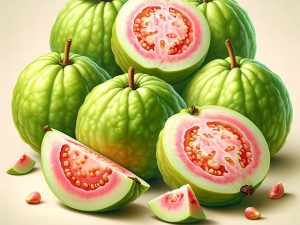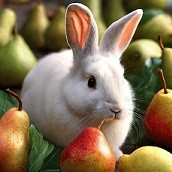Can Rabbits Eat Guava? Natural Diet, Safety & Nutritional Guide for Fruits
Key Takeaways:
- Rabbits can enjoy guava in moderation as part of a balanced diet.
- Guava is packed with fiber and vitamin C, but its seeds can be a choking hazard.
- Always introduce guava slowly to your rabbit’s diet to monitor for any adverse reactions.
- Wash guava thoroughly to remove any pesticides before offering it to your rabbit.
- Limit the amount of guava to avoid issues from its high sugar content.
Guava as a Snack: Balancing Your Rabbit’s Diet

“Guavas | These guavas were yummy. If you don’t use some form… | Flickr” from flickr.com and used with no modifications.
As a rabbit owner, you want to share the best and tastiest treats with your furry friend. Guava, a tropical fruit, might catch your eye. But before you hand over a slice, let’s talk about whether it’s a good idea. Because rabbits have sensitive digestive systems, it’s crucial to understand what’s safe for them to eat.
Key Components of a Rabbit’s Daily Diet
Before we dive into the world of guava, let’s set the stage with what a rabbit’s daily diet should look like. Most importantly, your rabbit needs:
- Unlimited hay: It keeps their digestive system moving and teeth in check.
- Fresh water: Always available, clean, and fresh.
- Leafy greens: A variety of veggies keeps things interesting and nutritious.
- Pellets: A small number of high-fiber pellets complement their nutrition.
Now, where does guava fit into this? As a treat, and treats should only make up a small part of their diet.
Guava Nutritional Benefits: Fiber and Vitamin C
Guava is a powerhouse of nutrients. It’s rich in dietary fiber, which is great for your rabbit’s digestion, and vitamin C, an essential antioxidant. But remember, rabbits produce their own vitamin C, so while it’s beneficial, it’s not a necessity in their diet.
Safe Serving Sizes: How Much Guava Can a Rabbit Eat?

“Guava (Psidium guajava) Flower, Leaf, Care, Uses – PictureThis” from picturethisai.com and used with no modifications.
When it comes to treats, less is more. For guava, stick to these guidelines:
- Start with a small piece, about the size of your thumb nail, to see how they react.
- If they tolerate it well, you can offer this size once or twice a week at most.
Because moderation is key, this ensures they enjoy the benefits without any drawbacks.
Potential Health Boost: Antioxidants in Guava

“Guava (Psidium guajava) Flower, Leaf, Care, Uses – PictureThis” from picturethisai.com and used with no modifications.
Antioxidants play a vital role in maintaining your rabbit’s health by fighting free radicals. Guava is a good source of these antioxidants. Therefore, a little guava can contribute to their overall well-being.
The Role of Antioxidants for Rabbit Wellness
Antioxidants support the immune system and help keep your rabbit’s coat shiny and healthy. Besides that, they can reduce the risk of chronic diseases. Including antioxidant-rich foods like guava in your rabbit’s diet can be a part of this health strategy.
Age-Related Rabbit Health and Fruits
Younger and older rabbits have different nutritional needs. For instance, baby rabbits should stick to a more basic diet until they’re older. And senior rabbits? They might need an extra boost from nutrient-rich foods to maintain their health.
Feeding Practices: Introducing Guava to Your Rabbit

“Ripe fruits whole and cut on a white background | 🇩🇪Profes… | Flickr” from flickr.com and used with no modifications.
When you’re ready to introduce guava, do it slowly. Start with a tiny piece and watch for any changes in their behavior or stool. This cautious approach helps prevent digestive upsets.
Starting with Small Pieces: Portion Control
Portion control is crucial. A small piece of guava is enough to gauge how your rabbit will react without overwhelming their system.
Observing Your Rabbit After New Foods
After feeding guava, keep an eye on your rabbit. Look for signs of enjoyment, like eager eating or a happy demeanor. But also be vigilant for any negative reactions, such as a change in stool consistency or a lack of appetite.
Precautions: Guava Parts to Avoid for Rabbit Safety
While guava flesh is safe, other parts of the fruit are not. The seeds can be a choking hazard, and the skin, while not toxic, may have pesticide residues if not washed properly.
Seed Hazards: Choking Risks and Safe Alternatives
Always remove the seeds before offering guava to your rabbit. Choking is a serious risk, and it’s easily preventable by taking this simple step.
Pesticide Concerns: Choosing and Washing Guava
Choose organic guava when possible to minimize pesticide exposure. Regardless, wash the fruit thoroughly under running
Remember, the goal is to enrich your rabbit’s diet without causing harm. By following these guidelines, you’re on the right path to doing just that.
Understanding Guava’s Side Effects on Rabbits
Now, let’s address the elephant in the room: the side effects of guava on rabbits. While guava is nutritious, it also has a high sugar content. This means you need to be mindful of the quantity you offer.
High Sugar Content: Balancing the Risks
Too much sugar can lead to weight gain and dental issues in rabbits. That’s why it’s crucial to keep guava as a rare treat, not a staple of their diet.
Signs of Digestive Discomfort in Rabbits
If your rabbit eats too much guava, they might experience digestive discomfort. Watch out for signs like:
- Diarrhea or softer stools
- A decrease in appetite
- Lethargy or a change in behavior
If you notice any of these symptoms, it’s time to cut back on the guava and consult your vet.
Nutritional Guide: When to Feed Your Rabbit Guava
Feeding your rabbit guava can be a delightful addition to their diet when done correctly. Here’s how to get it right:
Optimal Feeding Times and Frequency
Choose a time when your rabbit is most active to offer guava, as this is when they’re most likely to digest it well. Once or twice a week is plenty.
Adjusting Portions for Rabbit Size and Breed
Smaller breeds need less, while larger breeds might handle a bit more. But even for big bunnies, keep guava portions small.
Final Thoughts: Integrating Guava into a Rabbit’s Diet
Incorporating guava into your rabbit’s diet can be a wonderful treat if you keep the portions small and infrequent. Remember, a rabbit’s diet should be primarily
Article-at-a-Glance: Can Rabbits Eat Guava?
- Guava is safe for rabbits in small, seedless portions.
- Introduce guava slowly and watch for any adverse reactions.
- Always wash the fruit to remove pesticides.
- Limit guava due to its high sugar content to prevent health issues.

Frequently Asked Questions
Is guava safe for all breeds of rabbits?
Yes, guava is safe for all breeds, but always in moderation and without seeds.
How do I prepare guava for my rabbit?
Wash the guava, remove the seeds, and cut it into small pieces suitable for your rabbit’s size.
Can baby rabbits have guava?
Baby rabbits should not have guava until they are at least 7 months old and their digestive systems are more mature.
What parts of the guava plant are unsafe for rabbits?
The seeds and any unwashed skin should be avoided to prevent choking and pesticide ingestion.
How can I tell if my rabbit enjoys guava?
Your rabbit may show excitement or eagerness when eating guava. However, always monitor their reaction and stool afterward to ensure they’re not having any negative side effects.







Leave a Reply